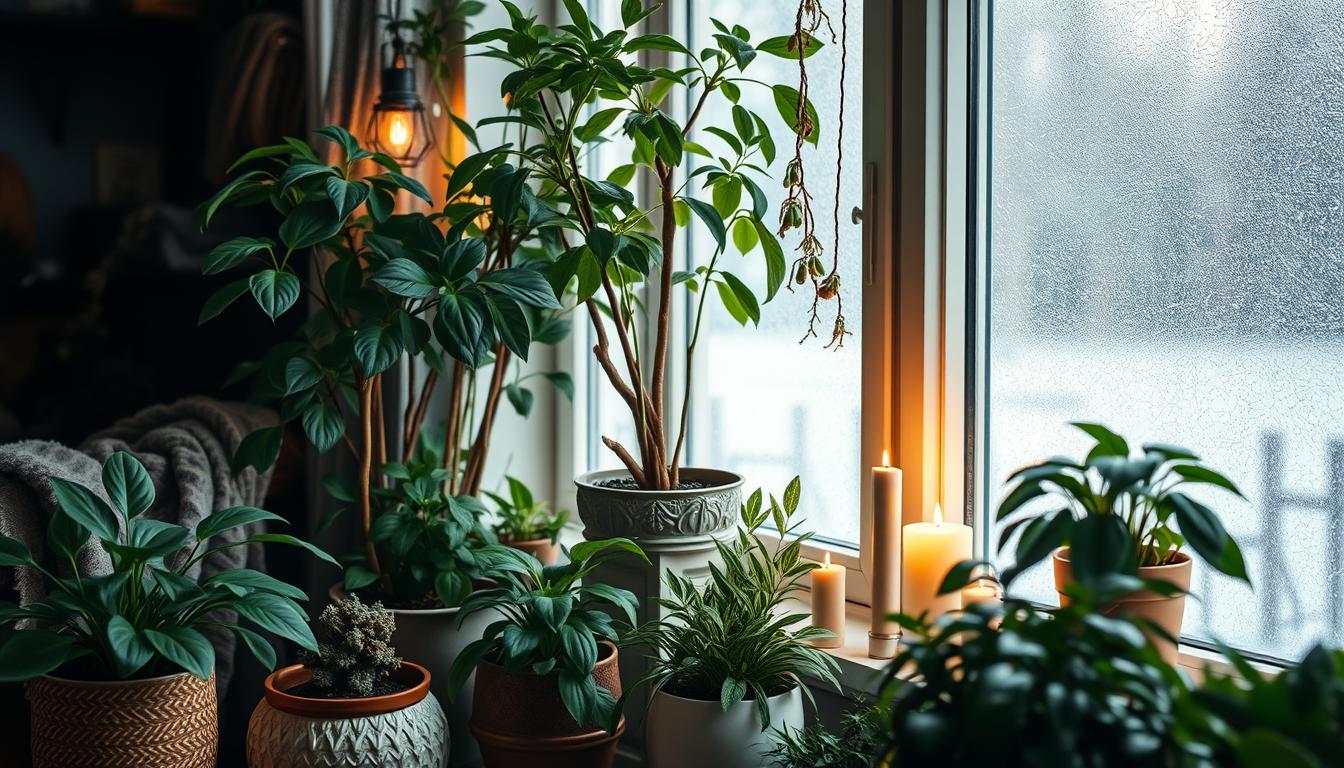As winter comes, I think about how to protect my plants. I love gardening and want to share my winter plant care tips. With the right steps, your plants can stay healthy even when it’s cold.
It’s important to know how to protect plants in winter. Winter brings challenges like frost and cold. By using the right tips, you can help your plants survive the winter.
In this article, I’ll share my knowledge on winter plant care. I’ll talk about choosing the right spot, insulating outdoor plants, and adding heat. By the end, you’ll know how to keep your plants safe and healthy all winter.
Understanding the Winter Challenges for Plants
Winter can be tough on plants. To care for them right, I must know what they face. It’s key to protect them from frost and keep the garden safe.
Several things affect plants in winter. Frost, cold temperatures, and less sunlight are big challenges. Frost harms plant tissues, cold slows growth, and less sunlight makes photosynthesis tough.
Frost and its Effects
Frost is especially hard on plants. It freezes water in cells, causing damage or death. To shield my plants, I cover them or move them inside.
Low Temperatures
Cold temperatures slow down plant growth. Most plants thrive in 65-75°F (18-24°C). Below 55°F (13°C), growth slows, and below 40°F (4°C), damage occurs.
Reduced Sunlight
Less sunlight in winter hurts plant growth. Plants need sunlight for photosynthesis, vital for energy. I use grow lights to make up for the lack of sunlight.
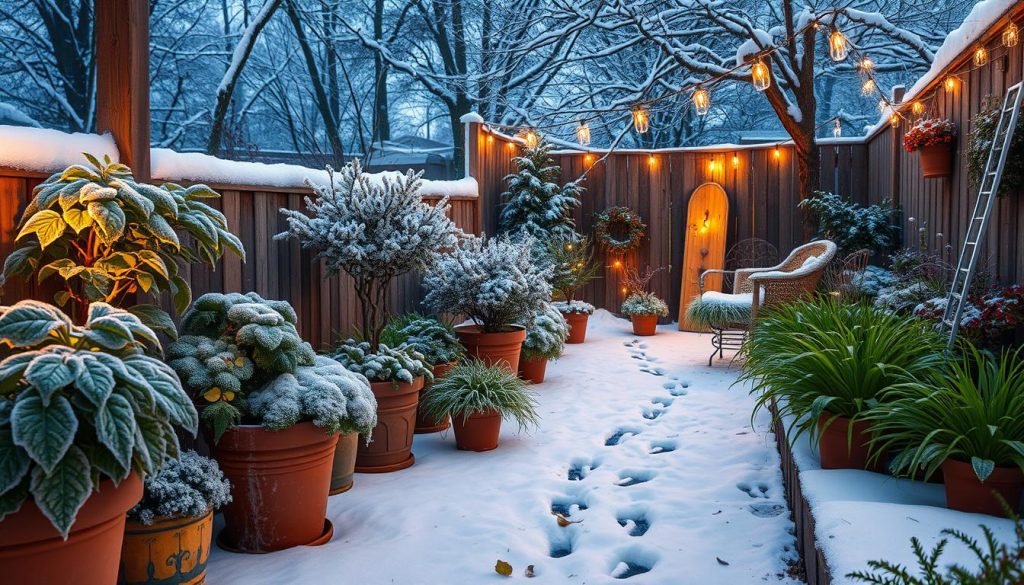
Knowing winter’s challenges helps me protect my plants. I shield them from frost, protect the garden, and ensure they get the right light and warmth.
| Challenge | Effect on Plants | Protection Measures |
|---|---|---|
| Frost | Cell damage or death | Covering with frost blanket, bringing indoors |
| Low Temperatures | Slowed growth and metabolism | Providing heat, insulating plants |
| Reduced Sunlight | Affected photosynthesis | Using grow lights, providing supplemental light |
Choosing the Right Location for My Plants
Choosing the right spot for my plants is key in cold weather. Indoor spots protect from frost and extreme temps. Outdoor spots offer more sunlight, vital for growth.
Using a greenhouse is also a good idea. It creates a controlled space for my plants, especially when sunlight is low in winter. Important things to think about include:
- Temperature: Will my plants be safe from extreme temps?
- Light: Will they get enough sunlight for growth?
- Moisture: Will they stay dry or not too wet?
By thinking about these, I can pick the best spot for my plants. This ensures they stay safe during winter. 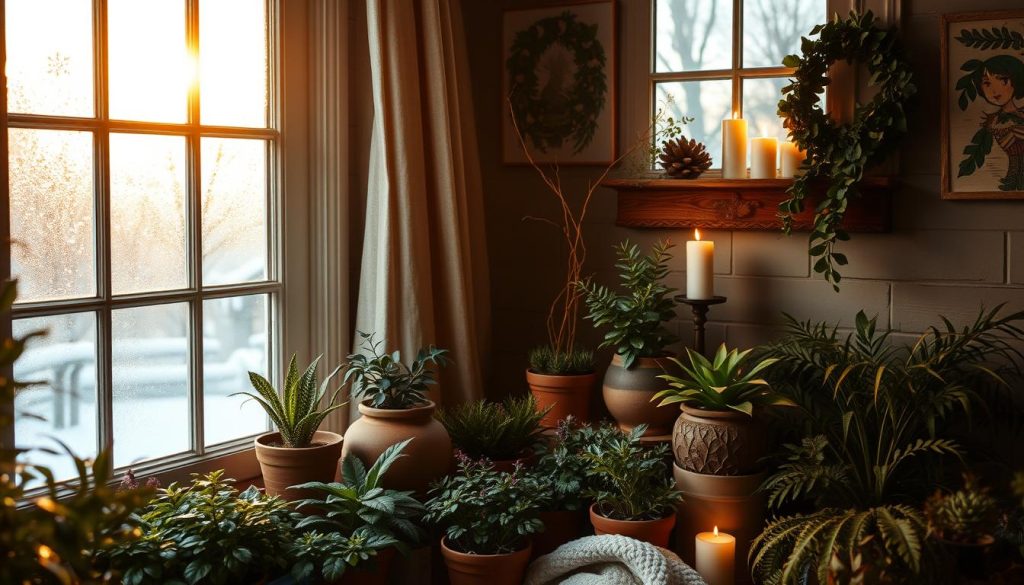
Indoor vs. Outdoor Options
Indoor spots are cozy and safe for plants. Outdoor spots offer more space and sunlight. The best spot depends on my plants’ needs and what I have.
Utilizing a Greenhouse
A greenhouse is great for winterizing plants. It lets me control temperature, light, and moisture. This creates a perfect environment for my plants to thrive.
Sunlight Exposure Considerations
Sunlight is crucial for photosynthesis and growth. I need to make sure my plants get enough sunlight. This helps them stay healthy and strong in winter.
Insulating My Outdoor Plants
As winter comes, I make sure my outdoor plants are safe from frost and cold. I use mulch, homemade covers, and burlap to keep them warm. These steps help my plants stay healthy and strong during the cold months.
I start by putting a thick layer of mulch around my plants. This keeps the heat and moisture in, preventing frost damage. I also make covers from breathable materials to shield them from wind and cold. Using burlap is another good choice, as it lets air and moisture through while keeping plants warm.
Benefits of Insulation
- Retains heat and moisture
- Reduces risk of frost damage
- Protects plants from harsh winds
By using these methods, I can enjoy my plants all year, even in winter. Protecting them from the weather and giving them the right care is key. With a bit of creativity and natural materials, my plants stay safe and healthy. They’ll be ready to thrive when spring comes.
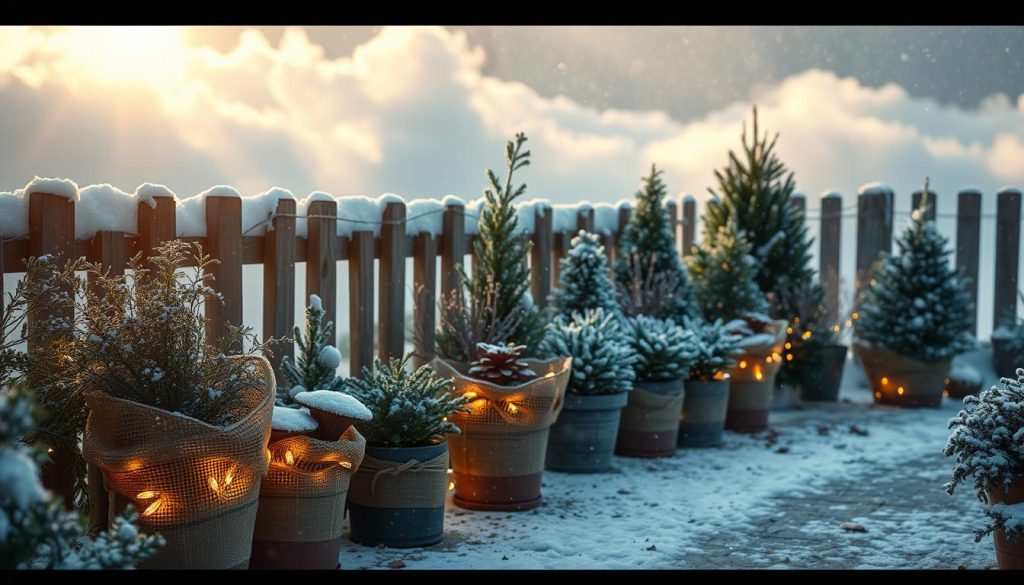
Watering My Plants in Winter
As winter comes, I pay extra attention to watering my plants. This is key to stop them from drying out or getting root rot. The cold and less sunlight mean they need less water. So, I adjust how often I water to keep them healthy.
It’s important to check the soil moisture and change the watering schedule as needed. In the cold, the soil dries out slower. I watch for signs like wilted leaves and dry soil. This way, I can act fast to help my plants.
Adjusting the Watering Schedule
To change my watering schedule, I think about a few things:
- Soil type: Different soils hold water differently, so I adjust my watering based on this.
- Plant species: Some plants get dehydrated faster than others. I focus on their needs first.
- Temperature: When it gets colder, my plants need less water. So, I water them less often.
Best Practices for Watering
Here are some tips for watering my plants in winter:
- Water in the morning: This lets the plants soak up the water all day.
- Don’t overwater: Too much water can cause root rot. So, I’m careful not to water too much.
- Use room-temperature water: Cold water can shock my plants. So, I use water that’s around room temperature.
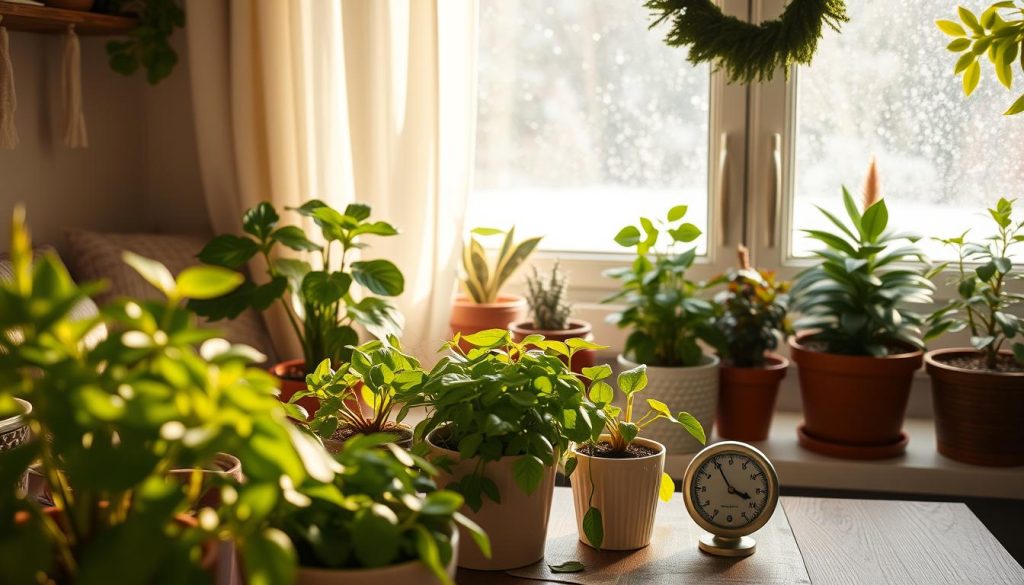
Providing Additional Heat
As I focus on winter plant care, I’ve learned that extra heat is key. It helps protect my plants from cold damage. This keeps them healthy all winter long. Keeping plants safe is very important during this time.
I start by using heat mats to warm the soil. This encourages healthy root growth. I also set up grow lights to give them more light. This is because winter sunlight is less.
- Creating warm microclimates, such as using a cold frame or a hoop house, to retain heat and protect plants
- Utilizing thermal mass, like brick or stone, to absorb and release heat
- Insulating plants with materials like straw or bubble wrap to keep them warm
By using these methods, I keep my plants safe from winter’s cold. Protecting plants well is key to their health and growth, even in the coldest times.
Protecting Potted Plants
As winter comes, potted plants need special care to avoid frost damage and dehydration. It’s key to protect them from frost to keep them alive. Bringing them inside is a good way to shield them from harsh temperatures.
Bringing Them Indoors
When moving plants inside, pick a spot with enough sunlight and a steady temperature. A sunny windowsill or a heated greenhouse works well for winter protection.
Wrapping Pots for Insulation
For plants that can’t go inside, insulate the pots to keep heat in and frost out. Use bubble wrap or foam sheets for this.
Choosing the Right Location
When picking a spot for plants, think about sunlight and wind protection. A spot with southern exposure gets enough sunlight. A place that blocks wind helps prevent dehydration.
Some tips for protecting potted plants include:
- Using a thermometer to monitor temperature
- Watering plants sparingly to prevent dehydration
- Providing humidity to prevent dryness
By following these tips and taking the right steps, your potted plants can stay healthy all winter. This ensures they get the winter garden protection they need.
| Plant Type | Protection Method |
|---|---|
| Potted plants | Bring indoors, wrap pots with insulation |
| Sensitive plants | Provide extra protection, such as a heated greenhouse |
Monitoring Plant Health
As winter comes, I make sure to keep a close eye on my plants. Regular checks help me spot problems early. This way, I can fix them quickly and keep my plants healthy.
Some important things to watch for include:
- Regular inspections to identify signs of stress or disease
- Keeping an eye on pests, such as spider mites and mealybugs, to prevent infestations
- Documenting growth and progress to identify patterns or trends
By staying vigilant, I can fix issues fast. This is key in winter, when plants face more challenges. Good care helps them stay strong and healthy.
Regular checks and care help my plants get through winter well. This way, they’re ready to thrive when spring comes. Keeping them healthy means I get to enjoy their beauty all year.
Fertilizing My Plants in Winter
As winter comes, I focus more on my plants’ needs. I’ve learned that fertilizing them is key for their health. It’s important to avoid overfertilizing, which can harm them. I choose a balanced, water-soluble fertilizer for the best nutrients.
Fertilizing in winter is tricky due to the cold and less sunlight. I’ve made a special schedule for my plants. This helps meet their needs better.
Key Considerations for Winter Fertilization
- Choose a balanced and water-soluble fertilizer that provides essential nutrients
- Adjust the frequency of application to prevent overfertilization
- Monitor plants for signs of nutrient deficiency, such as yellowing leaves and stunted growth
By following these tips, I keep my plants healthy through winter. Good care and the right nutrients make a big difference. My plants stay vibrant and strong.
Preparing for Spring
As winter fades, it’s time to get my plants ready for spring. A few steps can help them grow well in the warmer months. This ensures a smooth transition.
Transitioning Back Outdoors
Once frost is gone, I’ll slowly move my plants outside. This helps them adjust without shock. I start with partial shade, then increase sunlight gradually.
Pruning Post-Winter
Winter can damage plants. I’ll prune dead parts to encourage new growth. This makes my plants look better and grow stronger.
Planning for New Growth
Preparing for spring also means planning for growth. I might divide and repot plants. Adding fresh soil and nutrients helps them thrive.

